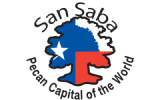Historical Downtown Walking Tour Guide
Step back in the past and experience the history of the buildings that compose our historic downtown district. Our Walking Tour Guide, available at the Visitor’s Center, is complete with historic photos, timeline, narratives, and map and picture legend, as your aid to glimpse into the life and bygone days of downtown San Saba.


